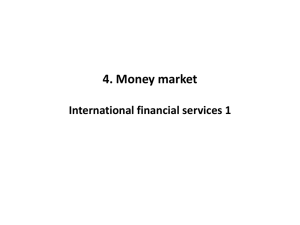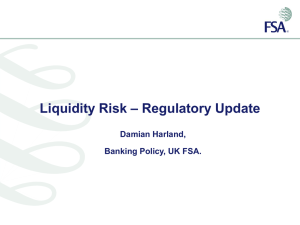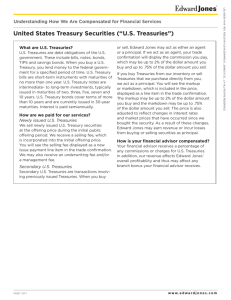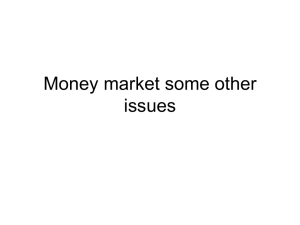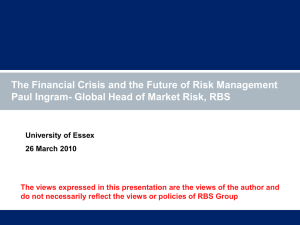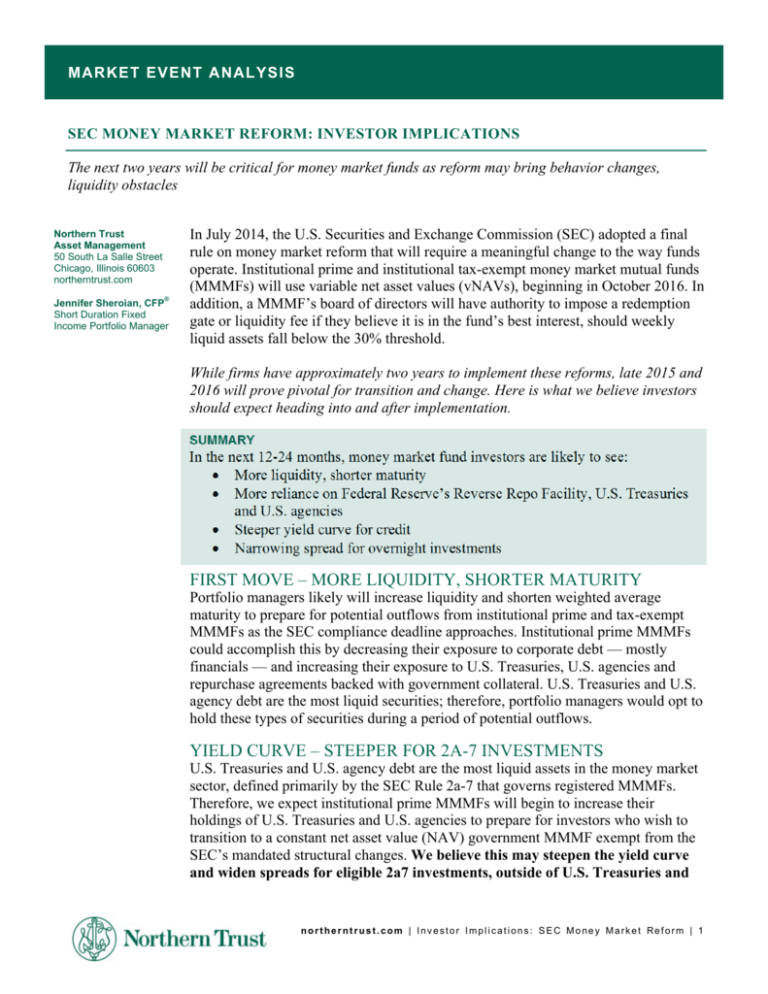
MARKET EVENT ANALYSIS
SEC MONEY MARKET REFORM: INVESTOR IMPLICATIONS
The next two years will be critical for money market funds as reform may bring behavior changes,
liquidity obstacles
Northern Trust
Asset Management
50 South La Salle Street
Chicago, Illinois 60603
northerntrust.com
®
Jennifer Sheroian, CFP
Short Duration Fixed
Income Portfolio Manager
In July 2014, the U.S. Securities and Exchange Commission (SEC) adopted a final
rule on money market reform that will require a meaningful change to the way funds
operate. Institutional prime and institutional tax-exempt money market mutual funds
(MMMFs) will use variable net asset values (vNAVs), beginning in October 2016. In
addition, a MMMF’s board of directors will have authority to impose a redemption
gate or liquidity fee if they believe it is in the fund’s best interest, should weekly
liquid assets fall below the 30% threshold.
While firms have approximately two years to implement these reforms, late 2015 and
2016 will prove pivotal for transition and change. Here is what we believe investors
should expect heading into and after implementation.
SUMMARY
In the next 12-24 months, money market fund investors are likely to see:
More liquidity, shorter maturity
More reliance on Federal Reserve’s Reverse Repo Facility, U.S. Treasuries
and U.S. agencies
Steeper yield curve for credit
Narrowing spread for overnight investments
FIRST MOVE – MORE LIQUIDITY, SHORTER MATURITY
Portfolio managers likely will increase liquidity and shorten weighted average
maturity to prepare for potential outflows from institutional prime and tax-exempt
MMMFs as the SEC compliance deadline approaches. Institutional prime MMMFs
could accomplish this by decreasing their exposure to corporate debt — mostly
financials — and increasing their exposure to U.S. Treasuries, U.S. agencies and
repurchase agreements backed with government collateral. U.S. Treasuries and U.S.
agency debt are the most liquid securities; therefore, portfolio managers would opt to
hold these types of securities during a period of potential outflows.
YIELD CURVE – STEEPER FOR 2A-7 INVESTMENTS
U.S. Treasuries and U.S. agency debt are the most liquid assets in the money market
sector, defined primarily by the SEC Rule 2a-7 that governs registered MMMFs.
Therefore, we expect institutional prime MMMFs will begin to increase their
holdings of U.S. Treasuries and U.S. agencies to prepare for investors who wish to
transition to a constant net asset value (NAV) government MMMF exempt from the
SEC’s mandated structural changes. We believe this may steepen the yield curve
and widen spreads for eligible 2a7 investments, outside of U.S. Treasuries and
northerntrust.com | Investor Implications: SEC Money Market Reform | 1
U.S. agencies. Steepening could occur if prime MMMFs start reinvesting proceeds
of their bank certificate of deposit (CD)/commercial paper (CP) maturities into U.S.
debt instead of reinvesting it with financial institutions. Currently, three-month CDs
have a spread of around 17 basis points (bps) over three-month U.S. Treasury bills.
On average, three-month bank CDs yield around 19 bps compared to a three-month
U.S. Treasury bill set at 2 bps. However, heightened demand for U.S. Treasuries and
U.S. agencies ultimately could push yields lower and dampen demand for typicalterm investment instruments. These typical-term instruments, traditionally relied on
by prime funds, could see yields spike in order to attract investors.
Current Investment Yields for Money Market Instruments
45
40
FedEffectiveRate
35
DealerRepo
30
FedRepo
25
Credit
20
Treasury
15
U.S.agencydiscountnote
10
5
0
o/n
1month
3month
6month
1year
Source: Bloomberg
SPREAD – NARROWER FOR OVERNIGHT INVESTMENTS
Overnight maturity time deposits relied upon by money market funds would attract
even higher demand as institutional prime 2a-7 funds build their overnight cash
positions to prepare for potential outflows. In the current environment for overnight
investments, most time deposits pay a premium over agency discount notes,
repurchase agreements and the Federal Reserve’s reverse repo facility, except on
quarter-end and year-end. Even now, however, it is not unusual for financial
institutions to limit the amount of overnight cash they accept. We expect this
dynamic will continue, especially as banks conform to new regulations by lowering
their needs for short-term funding and money funds demand a greater supply of time
deposits, since they will be holding more short-term cash. The spread also could
narrow among all overnight investment options as more cash is positioned at the very
front end of the yield curve, chasing fewer assets.
northerntrust.com | Investor Implications: SEC Money Market Reform | 2
Firms also likely will manage institutional prime money market funds more
conservatively to help ensure the funds are well-positioned to avoid instituting a
liquidity fee or redemption gate if weekly liquid assets fall below the 30%
threshold. As a result, these funds are likely to increase their allocation to
instruments categorized as daily and weekly liquid assets. Daily liquid assets are
comprised of cash, U.S. Treasuries and any security that matures in one business day
or is subject to a demand feature that can be exercised and payable within one
business day. Of course, weekly liquid assets include daily liquid assets but also
include U.S. agency discount notes issued at a discount with a maturity within 60
days and any security that matures in five business days or is subject to a demand
feature that can be exercised and payable within five business days. The municipal
variable-rate demand note is an example of a security with a demand feature. It has a
remarketing feature that allows the holder to put it back to the liquidity provider and
receive cash either that day or in five business days.
REPURCHASE AGREEMENTS — FUND RELIANCE TO GROW
Institutional prime money market funds will also rely more heavily on repurchase
agreements as fund managers prepare for the possibility of potential outflows. This
poses an interesting scenario, since dealer balance sheets have been declining due to
recent bank regulations that somewhat handicap dealers’ repo balances by making it
more costly for dealers to fund.
BASEL III — IMPLICATIONS FOR GLOBAL FINANCIAL
INSTITUTIONS
The implication of new regulations affecting global financial institutions is another
dynamic working against money market fund supply. After the 2008 financial crisis,
the Basel Committee on Banking Supervision agreed to enact reforms strengthening
the banking sector globally. These new regulations force banks to rely less on
short-term funding sources (the same type of funding that 2a-7 funds heavily rely
on). Basel III, and specifically the supplementary leveraged ratio (SLR), suggests a
3% minimum capital requirement on all assets. Over the last few years, we have seen
a reduction in dealers’ repo books because the margins dealers earn on traditional
repos — which includes U.S. Treasuries, U.S. agency debt and agency-backed
mortgage pools — are not even close to meeting the 3% capital buffer. As a result,
banks are shrinking and even exiting businesses are unable to hit their established
targets. With the current near-zero rates, dealer banks often take a loss on traditional
repos.
LIQUIDITY COVERAGE RATIO
The liquidity coverage ratio (LCR) is another factor affecting the supply of repo,
unsecured funding and high quality liquid assets. In the past, regulators focused on
risk-weighted assets, but now the requirement is to hold assets dollar-for-dollar,
regardless of the type. To comply with LCR, banks now limit funding maturing
within 30 days and instead hold high-quality assets, dollar-for-dollar, for all repos
and unsecured funding rather than holding cash collateral. These high quality assets
northerntrust.com | Investor Implications: SEC Money Market Reform | 3
include Fed deposits, U.S. Treasuries, U.S. agencies and very select investmentgrade corporate issuers. Most U.S. agencies can only contribute to 85% of the LCR.
The investment-grade corporate issuer, which may be considered a high quality
liquid asset for LCR purposes, can only count toward 50% of the LCR. Additionally,
overall exposure of high quality corporates is capped at 15% of high quality liquid
assets. As a result, a bank would prefer to hold assets accounting for 100% of LCR,
such as U.S. Treasuries, rather than those incurring a haircut. The concept is that if a
bank cannot fund itself, then the bank could sell these highly liquid assets. Since the
LCR requires banks to hold high quality liquidity assets against a 30-day stressed
period of expected net cash outflows, this ultimately leads banks to limit their
funding maturing within 30 days. Many banks instead abide by a much more
conservative approach, such as 90 days. As a result, however, dealers are less willing
to play the vital role of market-maker than they were in the past. Besides being
required to hold more high quality assets such as Treasuries, dealers find their shortterm funding needs have diminished somewhat. Another consequence of the LCR is
that banks must instead fund longer term, since this rule disincentivizes short-term
funding needs. In addition, liquidity and supply on high quality assets such as U.S.
Treasuries will decrease since the banks will be holding more of these securities in
order to comply with the LCR.
Money Market Fund Industry
The industry totaled $2.69T as of 2/12/15
Government‐Retail
Gov't‐Institutional
Prime‐Retail
Prime‐Institutional
Tax‐Exempt‐Retail
Tax‐Exempt‐Institutional
3%
7%
7%
29%
35%
19%
Source: ICI
northerntrust.com | Investor Implications: SEC Money Market Reform | 4
OVERNIGHT REVERSE REPO FACILITY — A LIFESAVER FOR ELIGIBLE
MONEY MARKET FUNDS?
The Federal Reserve’s Overnight Reverse Repo Facility is an alternative to dealer
repos for 165 new eligible counterparties that currently include money market funds
in excess of $5 billion assets under management, government-sponsored enterprises,
banks and primary dealers. Since operational exercises for the facility began on
September 23, 2013, the facility has seen the most demand when bank funding is
most scarce. A record $339 billion was tapped on June 30, 2014, more than three
times the $105 billion average for the month of June before the June 30 surge. The
Federal Reserve added another twist after the September 2014 Federal Open Market
Committee (FOMC) meeting. It capped the facility at $300 billion, and required
counterparties to submit bids in a Dutch auction format. The maximum rate accepted
was 0.05%, and negative rates were also permitted. Once the changes were
announced, the four-week Treasury bill and Federal Home Loan Bank discount note
auctions cleared at or near zero bps. Banks also began to term out their overnight
needs to one-week trades – of course, at much richer levels – to help money market
funds and other short term investors get invested over quarter-end. On September 30,
2014, 102 counterparties submitted bids totaling $407.2 billion, ranging from 0.05%
to -0.20%, with the rate set at 0.00%. However, only $300 billion was awarded.
The Federal Reserve highlighted in its June 2014 FOMC minutes that it does not
intend for this to be “a permanent part of the Committee’s longer run operating
framework.” However, eligible money market funds could rely heavily on this
facility to help the fund get fully invested. It was initially expected that the Fed
Reverse Repo Facility would become full allotment — meaning, there would not be
a limit to the overall size of the facility or maximum size per counterparty — and
that eligible counterparties would expand during the normalization process. One of
the facility’s goals is to help put a floor on short term interest rates. However, if the
current process is not improved, it is unlikely this facility will become full allotment
or that the number of counterparties will be expanded much beyond the current
approved counterparties; therefore, the goal of setting a rate floor would become
impossible. It also appears that the FOMC is perhaps rethinking the full allotment
and that the program will remain capped at a certain dollar amount, especially after
the steps taken to modify the program in September and December. A term reverse
repo option was introduced in December to help alleviate year-end pains, like the
overnight facility it was capped at the maximum $300 billion. They also have
introduced additional testing of the term reverse repo facility for February and March
2015.
northerntrust.com | Investor Implications: SEC Money Market Reform | 5
SUMMARY — DEMAND MAY OUTSTRIP SUPPLY
We think these new MMMF reform regulations may foster strong demand that likely
will outstrip supplies of high-quality, short-term assets. This could help keep yields
in the short end of the curve relatively low even after the Fed starts tightening
monetary policy and rates begin rising.
What You Can Do Today
For more information on Northern Trust’s thinking on cash and short duration
investing, please refer to these helpful resources:
Balancing Yield and Risk. A cash segmentation strategy can help investors increase the
yield and incremental returns of their cash portfolios while maintaining an appropriate level of
risk.
Read “Balancing Yield and Risk with an Ultra-Short Strategy”
Interest Rates “Lower for Longer” Cash investors often see lost opportunities with a waitand-see approach for rising interest rates.
Read “Waiting for Interest Rates to Change Could Prove Costly”
IMPORTANT INFORMATION: This material is for information purposes only. The
views expressed are those of the author(s) as of the date noted and not necessarily of
the Corporation and are subject to change based on market or other conditions
without notice. The information should not be construed as investment advice or a
recommendation to buy or sell any security or investment product. It does not take
into account an investor’s particular objectives, risk tolerance, tax status, investment
horizon, or other potential limitations. All material has been obtained from sources
believed to be reliable, but the accuracy cannot be guaranteed.
PAST PERFORMANCE IS NOT INDICATIVE OF FUTURE RESULTS. Periods
greater than one year are annualized except where indicated. Returns of the indexes
also do not typically reflect the deduction of investment management fees, trading
costs or other expenses. It is not possible to invest directly in an index. Indexes are
the property of their respective owners, all rights reserved.
No bank guarantee | May lose value | NOT FDIC INSURED
© Northern Trust 2014
northerntrust.com | Investor Implications: SEC Money Market Reform | 6

